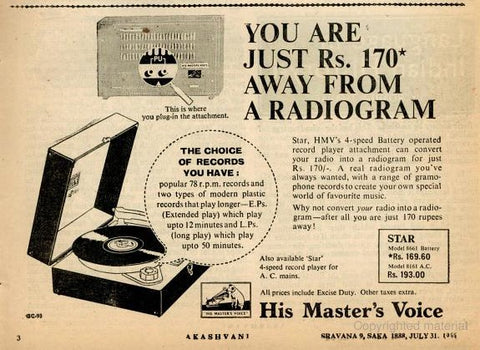Indian Audio Icons – Radiograms

From the 1930s to mid-1970s, the radiogram or console stereo was the quintessential integrated home audio solution. These exquisitely designed cabinets included a record player, radio receiver, amplifier, and loudspeaker in a form-factor that blurred the lines between living room décor and audio. In India, ownership of a radiogram was a status symbol and a part of the vision of modern living during the mid-20th century.

Radiograms began to gain popularity around the world starting in the 1930s, driven by a consumer demand for gramophone and radio set-ups that blended-in aesthetically with a respectable living or drawing room. The first radiograms were imported and sold in India during the British Raj.

The name Garrard is intrinsically associated with radiograms due to the popularity of Garrard record changers that were often used in these units. Formed in 1915, the British firm was famous by the 1930s for their record players and automatic record changers which allowed for continuous playback of multiple records. Garrard changers remained popular in radiograms well into the 1970s.

Such was the popularity of record changers, that many “albums” on 78rpm were sequenced according to the operation of changer mechanisms, which played one side of each record first, before the stack had to be flipped around for the other sides to play automatically.

By the mid-1950s, record changers used in radiograms often featured 3 speeds, allowing play-back of the then new LP and EP formats as well as the traditional 78s. During this time, the design of radiograms began to show the influence of post-war modernism, and today they are still regarded as quintessential examples of mid-century modern design.

In the 1960s, radiograms featuring Garrard changers and high-quality vacuum tube radio receivers were offered in India by HMV. More privileged customers such as film stars and industrialists often preferred the German makes such Grundig and Telefunken.


Such was the allure of the radiogram to the Indian middle class, that record players were often marketed as add-on attachments for radio sets that promised to “convert your radio into a radiogram”.

By the mid ‘70s, the bulky radiograms started to fall out of favour, as the coming of solid-state technology started a trend towards miniaturisation. Compact transistor radios, tape-decks, and component Hi-Fi systems started taking over the spotlight, and the radiograms of old were relegated to the scrap dealers. But today, as an interest in mid-century modern design explodes, perhaps it is time to give the radiogram another look as a media-hub for the living room.

Read More : Indian Audio Icons – Portable Record Players





